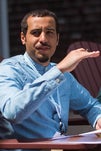- As the Midwest braced for a dangerous cold snap, Chicago Tribune reporter Tony Briscoe knew exactly how to place the record low temperatures into scientific context.
Biography
As the Midwest braced for a dangerous cold snap, Chicago Tribune reporter Tony Briscoe knew exactly how to place the record low temperatures into scientific context. “I knew who to reach out to and I felt like we did a good job,” says Briscoe of the Tribune’s coverage.
He credits Metcalf Institute’s 2018 Annual Science Immersion Workshop for Journalists with preparing him to cover these types of stories by strengthening his foundation in science. “Instead of the arduous task of trying to learn something on the fly, I already had the background,” says Briscoe, who contacted climate scientist and Metcalf Advisory Board member Jennifer Francis for an explanation of the connection between melting Arctic ice and extreme weather. “The fact that I was able to convey that to our readers was really helpful.”
Briscoe left Metcalf’s workshop on a mission – to convince his editors to promote him to the Tribune’s environmental beat. “I told them that there was no better time than now to add another environmental reporter, and they agreed,” says Briscoe. “Metcalf Institute has really changed the course of my career.”
Not long after his promotion, Briscoe’s science skills were put to the test with the release of the Fourth National Climate Assessment, a 1,700-page document prepared by the nation’s top scientists. “We were given one hour to review it before the press conference,” explains Briscoe. “The fellowship definitely helped me translate that dense scientific document and distill it for our audience.”
A graduate of Michigan State University with a Bachelor of Science degree in journalism, Briscoe began his career at The Detroit News, his hometown newspaper, covering fires, crime, gun violence and other stories. Unfortunately, it’s a beat that Briscoe says, “you almost feel pigeonholed into, as a journalist of color.”
When Briscoe joined the Chicago Tribune in 2014, he was able to add more variety to his reporting. He describes embarking on uncharted territory when he was assigned to cover a Michigan regulatory board’s decision to allow a major increase in the amount of water spilling into Lake Michigan from Lake Superior; a policy shift that many downstream residents opposed. “It was something I didn’t know anything about,” explains Briscoe, who relied on his natural curiosity as he set out to interview scientists. “I didn’t know that I would like doing environmental journalism until I was exposed to it.”
Briscoe would like to expose more journalists of color to the environmental beat, especially given the fact that “many Black and Hispanic communities are disproportionately impacted by environmental health threats” such as air pollution, hazardous waste, lead poisoning and water contamination. “It’s why I got into journalism, to listen to these communities and make them feel like they were being heard,” he says. “In some cases, these issues are quite literally a matter of life and death.”
One of Briscoe’s environmental stories focused on the Illinois Environmental Protection Agency’s failure to notify residents about plans to construct an asphalt plant near a Chicago park. Briscoe used SciLine, an online source-matching resource for journalists that he learned about during his Metcalf fellowship, to find an expert on asphalt plant emissions, and the Tribune was able to force the EPA to release public data on these types of projects. “They actually made reforms after the story was published,” says Briscoe.
As for Briscoe’s future career goals, he’s happy with the “coveted beat” he successfully pitched to his editors. “This is actually a dream job for me right now, being able to cover the environment and the Great Lakes,” says Briscoe. “I’m going to do my best to show my editors that there are a lot more environmental stories to be told.”
Read more alumni profiles
